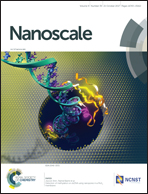Insight into the chemical adsorption properties of CO molecules supported on Au or Cu and hybridized Au–CuO nanoparticles†
Abstract
Although nanosized Au clusters have been well developed for many applications, fundamental understanding of their adsorption/activation behaviors in catalytic applications is still lacking, especially when other elements provide promotion or hybridization functions. Au hybridized with Cu element is a highly investigated system; Cu is in the same element group as Au and thus displays similar physicochemical properties. However, their hybrids are not well understood in terms of their chemical states and adsorption/activation properties. In this work, typical γ-Al2O3-supported Au and CuO as well as Au–CuO nanoparticles were prepared and characterized to explore their adsorption/activation properties in depth using CO as a probe molecule using advanced techniques, such as XPS, HR-TEM, temperature programmed experiments and operando DRIFT combined with mass spectra. It was found that gold and copper can both act as active sites during CO adsorption and activation. The CO-TPD and operando DRIFT results also revealed that CO molecules were able to react with surface oxygenated species, resulting in the direct formation of CO2 over the three samples in the absence of gaseous O2. The gold step sites (Austep) participated more readily in the reaction, especially under gaseous O2-free conditions. During adsorption, CO molecules were more preferentially adsorbed on Au0 sites at lower temperature comparing with those on the Cu0 sites. However, competitive adsorption occurred between CO adsorbed on Au0 and Cu0 with increased reaction temperature, and the synergy between the Au and Cu compositions was too strong to suppress the adsorption and activation of the CO molecules. The dynamic adsorption equilibrium over 120 °C to 200 °C resulted in the appearance of a hysteresis performance platform.



 Please wait while we load your content...
Please wait while we load your content...